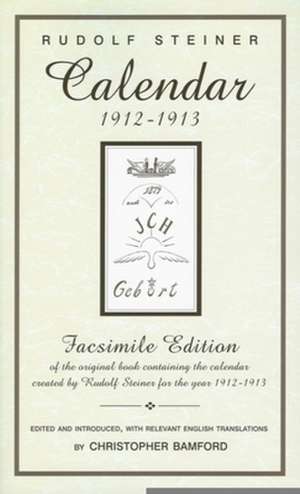Calendar 1912-1913: Facsimile Edition of the Original Book Containing the Calendar Created by Rudolf Steiner for the Year 1912-1913
Autor Rudolf Steiner Traducere de Christopher Banford, Hans Pusch, Ruth Puschen Limba Engleză Paperback – 23 mar 2005
Many are familiar with Rudolf Steiner s work "The Calendar of the Soul," the book of fifty-two weekly meditative verses that run from Easter to Easter. Few, however, know anything of its history. The form in which it appears today derives from the 1925 edition, which appeared only a few days after Steiner s death. This was the first printing of the verses in their current form as a commercially available edition. Seven years earlier, in 1918, an edition with a short introduction by Steiner appeared as the thirteenth of the Colorful Waldorf Astoria Booklets, tiny books packaged with Waldorf Astoria cigarettes and intended for soldiers in the trenches. The project was an initiative of Emil Molt, the owner of the cigarette company, an anthroposophist, and a close friend of Rudolf Steiner. It also appeared in a series of books edited by Molt s friend Hermann Hesse, intended for German prisoners of war. Neither edition was available to the public through bookstores.
The Calendar itself came into being seven years previously. Imma von Eckhardstein, who had been a member of Steiner s inner circle of coworkers since 1904, first had the idea in spring 1911. Soon afterword for health reasons Marie von Sivers decided to spend three months at Portorose, near Trieste, on the Adriatic. Imma von Eckhardstein accompanied her. Rudolf Steiner also spent much time there when not lecturing. Von Eckhardstein was given the task of illustrating the calendar, following Steiner s indications for new monthly zodiacal images, as well as for other images.
Publication was planned for the end of 1911, with the help of a grant from the Foundation for Theosophical Art. The actual printing occurred in Munich in March 1912, under the watchful eyes of Imma von Eckhardstein. Books were available in April. Only a limited edition was published, and it was never reissued.
On April 11, in Helsinki, following a special lecture for Russian members who had traveled from Moscow to hear him, Steiner showed his audience the new "Calendar 1912/13, " saying, Whoever meditates on these verses will achieve a great deal.
The calendar begins with an introduction by Steiner on the nature of a calendar as a way to connect past and future as well as earth and cosmos. It is important to get a sense of the movements of the Sun and Moon in relation to the planets and fixed stars. It is also important to bring the past into the present by invoking great beings in the evolution of consciousness on their appropriate birth or death days, and to celebrate the Holy Days. Steiner designed new zodiacal images for each month, traced the phases of the moon, and specified significant people, events, and/or festivals for each day. By living into the year in this way, one is ready for the meditative year as expressed by the weekly verses of the soul calendar."
Preț: 213.50 lei
Nou
Puncte Express: 320
Preț estimativ în valută:
40.87€ • 42.65$ • 34.26£
40.87€ • 42.65$ • 34.26£
Carte indisponibilă temporar
Doresc să fiu notificat când acest titlu va fi disponibil:
Se trimite...
Preluare comenzi: 021 569.72.76
Specificații
ISBN-13: 9780880105347
ISBN-10: 0880105348
Pagini: 159
Ilustrații: Illustrations
Dimensiuni: 157 x 257 x 15 mm
Greutate: 0.3 kg
Ediția:Facsimile ed.
Editura: Steiner Books
Locul publicării:United States
ISBN-10: 0880105348
Pagini: 159
Ilustrații: Illustrations
Dimensiuni: 157 x 257 x 15 mm
Greutate: 0.3 kg
Ediția:Facsimile ed.
Editura: Steiner Books
Locul publicării:United States
Notă biografică
Rudolf Steiner (1861-1925) was born in the small village of Kraljevec, Austro-Hungarian Empire (now in Croatia), where he grew up. As a young man, he lived in Weimar and Berlin, where he became a well-published scientific, literary, and philosophical scholar, known especially for his work with Goethe's scientific writings. At the beginning of the twentieth century, he began to develop his early philosophical principles into an approach to systematic research into psychological and spiritual phenomena. Formally beginning his spiritual teaching career under the auspices of the Theosophical Society, Steiner came to use the term Anthroposophy (and spiritual science) for his philosophy, spiritual research, and findings. The influence of Steiner's multifaceted genius has led to innovative and holistic approaches in medicine, various therapies, philosophy, religious renewal, Waldorf education, education for special needs, threefold economics, biodynamic agriculture, Goethean science, architecture, and the arts of drama, speech, and eurythmy. In 1924, Rudolf Steiner founded the General Anthroposophical Society, which today has branches throughout the world. He died in Dornach, Switzerland.
